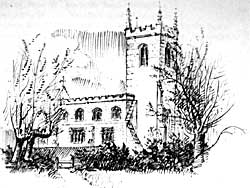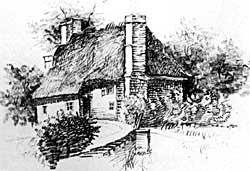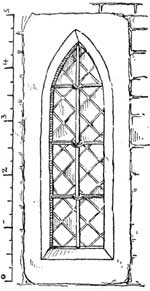The Summer Excursion
IN consequence of the war, the Council decided to modify the usual scope of the Society's excursions. Accordingly it was arranged to have half-day excursions only, and to limit our visits to churches in the city and its neighbourhood. As the Church of St. Peter, Nottingham, was under repair, and the architect, Mr. Robert Evans, was about to give an account of its restoration to the members of the Nottingham and Derby Architectural Society, arrangements were made for a combined meeting, on Wednesday, the 11th of August. In spite of stormy weather, about fifty members assembled at the Church of St. Giles, West Bridgford, at 2.30 p.m., where the following paper was read by Mr. Harry Gill.
West Bridgford Church
By Mr Harry Gill
IN consequence of the war, the Council decided to modify the usual scope of the Society's excursions. Accordingly it was arranged to have half-day excursions only, and to limit our visits to churches in the city and its neighbourhood. As the Church of St. Peter, Nottingham, was under repair, and the architect, Mr. Robert Evans, was about to give an account of its restoration to the members of the Nottingham and Derby Architectural Society, arrangements were made for a combined meeting, on Wednesday, the nth of August. In spite of stormy weather, about fifty members assembled at the Church of St. Giles, West Bridgford, at 2.30 p.m., where the following paper was read by Mr. Harry Gill.

North West view of the church.
The subject under consideration is the ancient parish church. We must, therefore, pay no regard for the moment to the extensive additions and alterations which have recently been made.
If you can imagine the north wall of the old nave to be standing in its original position (there was no aisle on the north side) you will have an idea of the size of the old church.
Age after age it had stood, embosomed in lush meadows, amidst a picturesque setting of pollarded willows, and hedgerows, which each recurring summer decked with a profusion of wild roses, until the last decade of the 19th century, when a building scheme was started, which has gradually transformed the ancient village into a modern suburb.
There is nothing left whereby we can tell with any certainty when the first Christian church was built at Bridgford.

The South West corner of the churchyard.
The great survey of A.D. 1086 records neither church nor priest; it does tell us that the village was known as Bridgford, even in those far-off times. The derivation of the name is quite simple, because at that time "ford" meant a place where a river might be crossed, and we know that a bridge was thrown across the Trent in the days of Edward the Elder (924) and it, and its successors on the same spot, have been in use ever since.
But for this bridge the village might conceivably have been known as "Gilesford" after the saint in whose honour the church is dedicated, just as the neighbouring village higher up-river became Wilford (Wilfrid's-ford) owing to the propinquity of church and ford.
At a later time the connection between the village and the bridge received further emphasis, for in the Taxation Roll of A.D. 1291 it is styled "Brigeford ad Pontem" (i.e. near to the bridge); and in a presentation of 1517, the incumbent is styled the "parson of ye ch of Briggeford next the Bridge-End of Nott."
The earliest written reference to the church is in this Taxation Roll of Pope Nicholas IV., where the value is returned at £17 6s. 8d.: but stones may tell a story as well as books, and the stones declare, by unmistakable signs, that a portion of the present work was executed 100 years at least before the date of the written record.
If we look at the lower portion of the rubble walling we shall see that for five feet above the ground it is built of skerry, or "water-stone" obtained locally. The priest's door is contemporary with this walling, and, until the enlargement of the church in 1898, there were two original windows in the north wall of the chancel, similar in size and shape to the "lancet" at the west end of the south aisle. This is "Early English" or 13th century work; or it may even be as early as the reign of Richard I. or John.
It is interesting to notice in passing that the entire window at the end of the aisle has been cut out of one slab of millstone grit, 5ft. long by 2ft. wide. In my opinion this is a later renewal of the original window, for gritstone would not be in use here at that early date, neither would the glass line have been placed so deeply in reveal.
Indications are not wanting that this end of the aisle was once screened off to form a school, or for some other secular purpose, and had a separate door of entrance west of the porch.
During the fifty years' reign of Edward III. (1327-1377), village churches throughout the land were enlarged or rebuilt in order to meet the needs of the more elaborate ritual then in vogue. The lord of the manors of Bridgford and Gamston,—at that time the knightly family of Luterell,— saw to it that this parish church was not left behind its neighbours in this respect.
 |
They did not pull the old church down entirely, for the foundations all round are the old work, but they gradually transformed it by putting in new and larger windows, and by the introduction of a rood-screen and loft, and other internal adornments. It is more than probable that seats would then be introduced for the first time; the men being accommodated on the south side, and the women on the north side:1 while the floor which formerly had been bare earth covered with rushes and herbs, would then be laid with boarding.
Although we have no record as to the precise date when these improvements were carried out, the "flowing" window tracery, and such minor details as the "buckle" or mask, to stop the hood moulding of the aisle window, point conclusively to the first quarter of the 14th century. A group at the east end, comprising two three-light windows, and a curvilinear2 triangular window in the gable, are unique in their way. They are a fine example of treatment which would gracefully adorn any village church. There were two square-headed windows in the north wall, one of four lights, the other of three lights: these have been cleaned and re-used in the new choir vestry; and two three-light windows on the south side which were re-made after the old pattern in 1871-2. With one exception (i.e. the northernmost of the twin-windows in the chancel, which I think is also a renewal and not the original work), the traceried head of each of these 14th century windows was cut and pierced out of a large slab of magnesian limestone, after the manner of 13th century plate tracery. This method of construction is common enough to-day, but at that time "bar-tracery," such as is used in the renewal of the northern window was generally employed.
All the window openings were filled in with richly coloured heraldic glass, some portions of which escaped even the Cromwellian period of church destruction and survived until quite recent times.
(1) "the chauncell to serve only for the priestes and clerks, the rest of the temporall multitude to be in the bodye of the churche separate notwithstanding, the men on the righte side and the women on the left." [Fardell of Facyons] translated into English by William Watreman and printed A.D. 1555.
(2) The triangular window was renewed in 1871, but the original plate is now in the porch.
